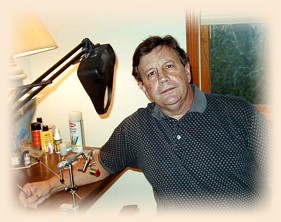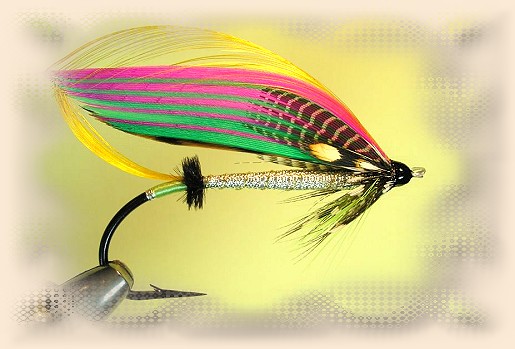This fly has always been a favorite of mine, and I decided
to present it here for a couple of reasons. First and foremost,
it's just a simple and beautiful salmon fly, without a lot of
folderol and gingerbread. The second reason I wanted to do it
is that, as full dress salmon flies go, it's relatively easy.
I thought that with the FAOL full dress salmon fly competition
looming it would be a good warm-up for me. I've seen several
posts on-line lately from people who wanted a good entry-level
fly so they could get started with the full dress flies with
married wings, and this fly seemed a natural. Why not put up
a good example? The joke was on me.
This "easy" fly, presented beautifully by Marvin Nolte in Judith
Dunham's book The Atlantic Salmon Fly, is not so
easy if you don't have all your ducks in a row, and I didn't.
I wound up tying no less than eight of these trying to get a
good one. First off, I was a bit out of practice with these,
and had some problems with proportions, getting the tails right,
which is critical, and some other things. But my main bugaboo
was the married wing, and it came down to materials. I tried to
"get away" with some things here, and with married wings that's
always a mistake. I had some leftover turkey feathers from other
flies, and tried to make do, over-dying them, and dying some
white ones that I had. Well, that simply didn't work because I
was using too hot a dye bath and the feathers were losing just
enough of their marrying qualities to make tying them in
successfully almost impossible. I tried using goose and turkey
combined, and didn't come out well there either. I found some
old green swan finally, and combined that with carefully
selected red goose pairs that I over-dyed with blue to get
a quasi-claret color, and finally got a set of wings. I did
one beautiful fly that when all was said and done turned out
to have a silver rib instead of the gold (it looked silver
on Marvin's fly, I swear). All in all, it's been a bit of
a nightmare.
So what did I learn, and is this really a good entry-level
fly? First off, yes, it's a dandy entry-level fly for someone
wanting a good starter for married wings. My problems really
came down to my own failure to not start with good matched
pairs of quality feathers that had the proper strand length.
I was using odds and ends and trying to marry them together,
some feathers having too much reverse curl, others coming
from the "wrong" side of the bird, etc. Marrying feathers
is the easiest thing in the world, as long as you start with
the right materials. I didn't, and paid the price. The thing
that makes this such a good entry-level fly though is the
lack of complications around the head. This is really the
hard part with a lot of full dress flies, trying to get the
cheeks, sides, shoulders, roof, topping, and horns on at the
head, and this fly is greatly simplified there. So get some
good matched pairs and tie away, it's not as hard as I made
it. Of course, it's always hard to get a good one. Here's
the recipe:
Francis Francis' Dusty Miller
Hook: Marvin Nolte used a 1/0 Partridge "Bartleet" on
his fly, which is not a blind-eye hook. I would highly recommend
that hook if you're just starting out, as it's a bit easier to
deal with than the blind-eye one shown in my example. I used a
3/0 Galic Supreme blind-eye hook, and had to really select goose
carefully for length. Getting long enough goose is always
something of a problem.
Tag: Silver twist and apple green floss.
Tail: Golden pheasant crest.
Butt: Black ostrich herl.
Body: Embossed silver tinsel.
Rib: Oval gold tinsel.
Throat: Olive saddle hackle and spotted guinea fowl.
Wings: Golden pheasant tail, and green and claret turkey
(used in Marvin's fly, you may use goose or swan as well).
Sides: Teal.
Cheeks: Jungle cock.
Topping: Golden pheasant crest
Head: Black. ~ EA
Credits: The Atlantic Salmon Fly by Judith Dunham.
About Eric:
 I started fly fishing as a teen in and around my hometown
of Plattsburgh, New York, primarily on the Saranac River.
I started tying flies almost immediately and spent hours
with library books written by Ray Bergman, Art Lee, and
A. J. McClane. Almost from the beginning I liked tying
just as much as I liked fishing and spent considerable
time at the vise creating hideous monstrosities that
somehow caught fish anyway. Then one day I came upon a
group of flies that had been put out at a local drug store
that had been tied by Francis Betters of Wilmington, N.Y.
My life changed that day and so did my flies, dramatically.
Even though I never met Fran back then, I've always
considered him to be one of my biggest influences.
I started fly fishing as a teen in and around my hometown
of Plattsburgh, New York, primarily on the Saranac River.
I started tying flies almost immediately and spent hours
with library books written by Ray Bergman, Art Lee, and
A. J. McClane. Almost from the beginning I liked tying
just as much as I liked fishing and spent considerable
time at the vise creating hideous monstrosities that
somehow caught fish anyway. Then one day I came upon a
group of flies that had been put out at a local drug store
that had been tied by Francis Betters of Wilmington, N.Y.
My life changed that day and so did my flies, dramatically.
Even though I never met Fran back then, I've always
considered him to be one of my biggest influences.
I had a career in music for twenty years or so and didn't
fish much, though I did fish at times. The band I was with
had its fifteen seconds of fame when we were asked to be in
John Mellencamp's movie "Falling From Grace." I am the
keyboard player on the right in the country club scene in
the middle of the movie. Don't blink. It's on HBO all the
time. We got to meet big Hollywood stars and record in John's
studio. It was a blast.
So how did I wind up contributing to the Just Old Flies
column on FAOL? I'm not sure, it was something that I simply
wanted very badly to do, and they let me. Many of the old flies
take me back to the Adirondacs and my youth, and I guess I get
to relive some of it through the column. I've spent many happy
hours fishing and tying over the years, and tying these flies
brings back memories of great days on the water, and intense
hours spent looking at the flies in the fly plates in the old
books and trying to get my flies to look like them. And now,
here I am, still doing that to this day. ~ EA
|


 I started fly fishing as a teen in and around my hometown
of Plattsburgh, New York, primarily on the Saranac River.
I started tying flies almost immediately and spent hours
with library books written by Ray Bergman, Art Lee, and
A. J. McClane. Almost from the beginning I liked tying
just as much as I liked fishing and spent considerable
time at the vise creating hideous monstrosities that
somehow caught fish anyway. Then one day I came upon a
group of flies that had been put out at a local drug store
that had been tied by Francis Betters of Wilmington, N.Y.
My life changed that day and so did my flies, dramatically.
Even though I never met Fran back then, I've always
considered him to be one of my biggest influences.
I started fly fishing as a teen in and around my hometown
of Plattsburgh, New York, primarily on the Saranac River.
I started tying flies almost immediately and spent hours
with library books written by Ray Bergman, Art Lee, and
A. J. McClane. Almost from the beginning I liked tying
just as much as I liked fishing and spent considerable
time at the vise creating hideous monstrosities that
somehow caught fish anyway. Then one day I came upon a
group of flies that had been put out at a local drug store
that had been tied by Francis Betters of Wilmington, N.Y.
My life changed that day and so did my flies, dramatically.
Even though I never met Fran back then, I've always
considered him to be one of my biggest influences.